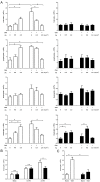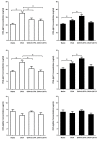Differential effects of formaldehyde exposure on airway inflammation and bronchial hyperresponsiveness in BALB/c and C57BL/6 mice
- PMID: 28591193
- PMCID: PMC5462467
- DOI: 10.1371/journal.pone.0179231
Differential effects of formaldehyde exposure on airway inflammation and bronchial hyperresponsiveness in BALB/c and C57BL/6 mice
Abstract
Epidemiological evidence suggests that formaldehyde (FA) exposure may influence the prevalence and severity of allergic asthma. However, the role of genetic background in FA-induced asthma-like responses is poorly understood. In the present study, we investigated the nature and severity of asthma-like responses triggered by exposure to different doses of FA together with or without ovalbumin (OVA) in two genetically different mouse strains-BALB/c and C57BL/6. Both mouse strains were divided into two main groups: the non-sensitized group and the OVA-sensitized group. All the groups were exposed to 0, 0.5 or 3.0 mg/m3 FA for 6 h/day over 25 consecutive days. At 24 h after the final FA exposure, the pulmonary parameters were evaluated. We found that FA exposure induced Th2-type allergic responses in non-sensitized BALB/c and C57BL/6 mice. In addition, FA-induced allergic responses were significantly more prominent in BALB/c mice than in C57BL/6 mice. In sensitized BALB/c mice, however, FA exposure suppressed the development of OVA-induced allergic responses. Exposure to 3.0 mg/m3 FA in sensitized C57BL/6 mice also led to suppressed allergic responses, whereas exposure to 0.5 mg/m3 FA resulted in exacerbated allergic responses to OVA. Our findings suggest that FA exposure can induce differential airway inflammation and bronchial hyperresponsiveness in BALB/c and C57BL/6 mice.
Conflict of interest statement
Figures





Similar articles
-
Adjuvant effects of gaseous formaldehyde on the hyper-responsiveness and inflammation in a mouse asthma model immunized by ovalbumin.J Immunotoxicol. 2011 Oct-Dec;8(4):305-14. doi: 10.3109/1547691X.2011.600738. Epub 2011 Aug 19. J Immunotoxicol. 2011. PMID: 21854218
-
Strain-specific phenotypes of airway inflammation and bronchial hyperresponsiveness induced by epicutaneous allergen sensitization in BALB/c and C57BL/6 mice.Int Arch Allergy Immunol. 2010;152 Suppl 1:67-74. doi: 10.1159/000312128. Epub 2010 Jun 4. Int Arch Allergy Immunol. 2010. PMID: 20523066
-
Induced pluripotent stem cells without c-Myc reduce airway responsiveness and allergic reaction in sensitized mice.Transplantation. 2013 Dec 15;96(11):958-65. doi: 10.1097/TP.0b013e3182a53ef7. Transplantation. 2013. PMID: 23989473
-
[Use of the mouse to unravel allergic asthma: a review of the pathogenesis of allergic asthma in mouse models and its similarity to the condition in humans].Arch Bronconeumol. 2005 Mar;41(3):141-52. doi: 10.1016/s1579-2129(06)60415-1. Arch Bronconeumol. 2005. PMID: 15766467 Review. Spanish. No abstract available.
-
The impact of formaldehyde exposure on lung inflammatory disorders: Insights into asthma, bronchitis, and pulmonary fibrosis.Chem Biol Interact. 2024 May 1;394:111002. doi: 10.1016/j.cbi.2024.111002. Epub 2024 Apr 9. Chem Biol Interact. 2024. PMID: 38604395 Review.
Cited by
-
Effect of Formaldehyde on Human Middle Ear Epithelial Cells.Biomed Res Int. 2018 Mar 26;2018:6387983. doi: 10.1155/2018/6387983. eCollection 2018. Biomed Res Int. 2018. PMID: 29780828 Free PMC article.
-
Prolonged smoldering Douglas fir smoke inhalation augments respiratory resistances, stiffens the aorta, and curbs ejection fraction in hypercholesterolemic mice.Sci Total Environ. 2023 Feb 25;861:160609. doi: 10.1016/j.scitotenv.2022.160609. Epub 2022 Dec 2. Sci Total Environ. 2023. PMID: 36470384 Free PMC article.
-
Formaldehyde in Hospitals Induces Oxidative Stress: The Role of GSTT1 and GSTM1 Polymorphisms.Toxics. 2021 Jul 30;9(8):178. doi: 10.3390/toxics9080178. Toxics. 2021. PMID: 34437496 Free PMC article.
-
Formaldehyde and asthma: a plausibility?Arch Toxicol. 2025 Mar;99(3):865-885. doi: 10.1007/s00204-024-03946-5. Epub 2025 Jan 19. Arch Toxicol. 2025. PMID: 39828805 Review.
-
Methacholine hyperresponsiveness in mice with house dust mite-induced lung inflammation is not associated with excessive airway constriction ex vivo.Exp Physiol. 2025 Sep;110(9):1336-1348. doi: 10.1113/EP092522. Epub 2025 Mar 28. Exp Physiol. 2025. PMID: 40153804 Free PMC article.
References
MeSH terms
Substances
Supplementary concepts
LinkOut - more resources
Full Text Sources
Other Literature Sources
Medical
Molecular Biology Databases

